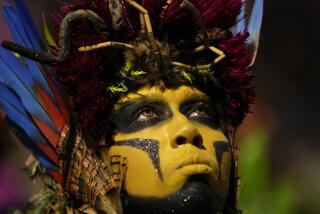Brazil makes contact with members of isolated tribe in Amazon
Reporting from SAO PAULO, Brazil — The government says that it has had a rare contact with members of one of a few isolated indigenous tribes along the border with Peru in the Amazon region, and that the group has suffered violent attacks and exposure to disease.
The Amazon region, especially in Brazil, is home to tribes that live by hunting and gathering and have never made significant contact with wider society. There are believed to be four such tribes in the Brazilian border region and two on the Peru side.
The group of seven people, who speak what is believed to be a language of the Pano linguistic group, crossed into western Brazil from Peru in June and made contact with another indigenous settlement, which notified the Brazilian government, said Brazil’s National Indian Foundation, or FUNAI. The government sent out a team of interpreters to find out what had happened.
FUNAI said in a statement this week that members of the tribe had contracted the flu and were treated at a government outpost deep in the Amazon before returning home. “In talks conducted with the group through interpreters, they said they had suffered acts of violence carried out by non-indigenous peoples at the head of the Envira River in Peru,” it said.
Brazil’s Amazon region is thought to be home to as many as 77 such isolated groups. This was the first significant contact with any isolated tribe since 1996, when FUNAI made contact with members of the Korubo tribe in an area to the north, the foundation said.
FUNAI has a policy of avoiding unwanted contact and preserving the land rights of indigenous groups. The suggestion that violence and disease in these fragile communities recently forced them off of their land and into contact with authorities, is troubling, indigenous rights groups say.
It’s extremely rare for the tribes to move into other groups’ land unless there is serious trouble, said Fiona Watson, research director at Survival International, an indigenous rights organization.
“This is extremely worrying,” said Watson, who added that her group had found evidence of logging, coca cultivation and drug trafficking near the indigenous-occupied region on the Peruvian side of the border.
“The most immediate question is of the flu. People who have had no contact for so long have no immunity to things like the flu or the common cold, and we know from past experience that it wasn’t uncommon after forced contact for half of the tribe to die,” she said.
“Something pushed them into this contact,” Watson said. “They said, or were able to show, that they had been shot at with firearms. Are there others that are being killed? That’s quite likely. These peoples have bow and arrows to defend themselves against heavily armed peoples.”
In 2010, FUNAI photographed some of the uncontacted peoples in a flyover to prove their existence and pressure the governments of Brazil and Peru to respect the inhabitants’ territories. The images showed a seemingly healthy and harmonious community. When members saw the aircraft, they daubed on red paint and grabbed their bows and arrows.
The individuals who made contact over the last month are not believed to be the ones in the photographs. There are an estimated 600 people in the tribal groups on the Brazilian side of the border.
In Peru and Brazil, indigenous communities have rights, but they are often violated by farmers or other landowners who plunder the groups’ land or expel them.
Bevins is a special correspondent.
More to Read
Sign up for Essential California
The most important California stories and recommendations in your inbox every morning.
You may occasionally receive promotional content from the Los Angeles Times.










